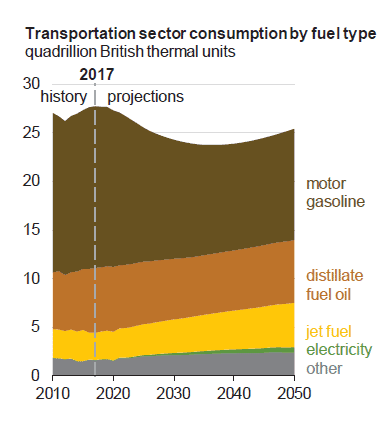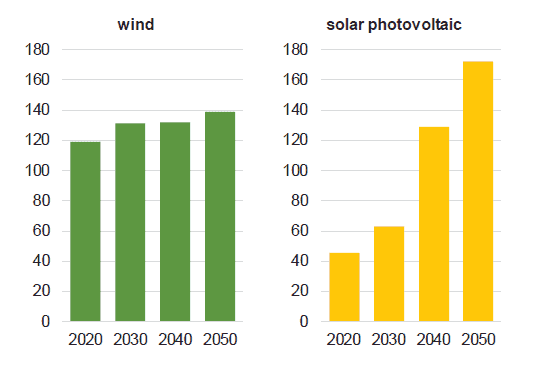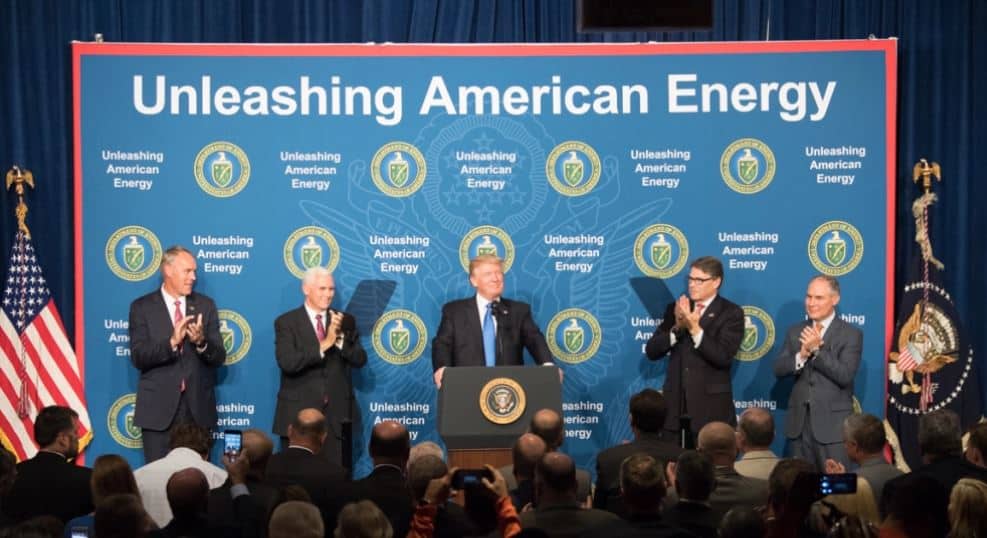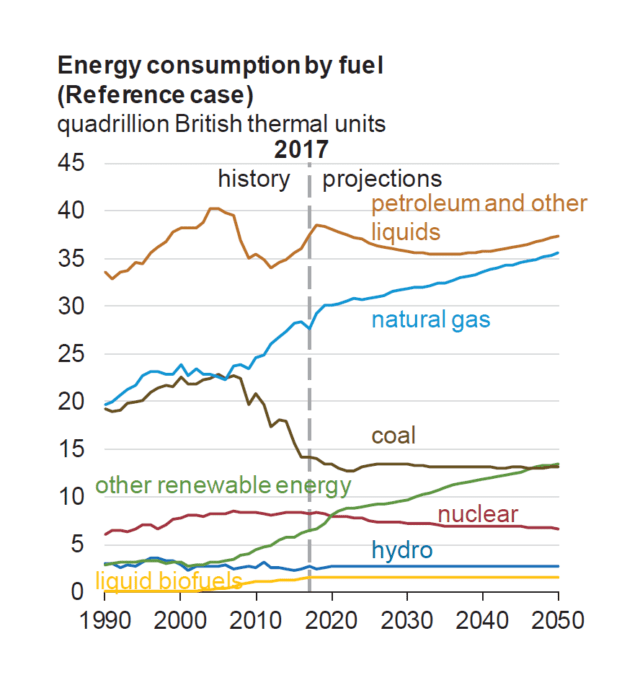Last week, the US Department of Energy (DOE) released its annual report projecting future US energy production and consumption and greenhouse gas (GHG) emissions. This year’s report, entitled Annual Energy Outlook 2018, with Projections to 2050 forecasts a nightmare scenario of increasing fossil fuel use, increasing emissions, lackluster adoption of renewable energy options, and a failure to shift to electric vehicles, even by mid-century.
The graph above is copied from that DOE report. The graph shows past and projected US energy consumption by fuel type. The top line shows “petroleum and other liquids.” This is predominantly crude oil products, with a minor contribution from “natural gas liquids.” For our purposes, we can think of it as representing liquid fuels used in cars, trucks, planes, trains, and ships. Note how the US DOE is projecting that in 2050 America’s consumption of these high-emission fuels will be approximately equal to levels today.
The next line down is natural gas. This is used mostly for heating and for electricity generation. Note how the DOE is projecting that consumption (i.e., combustion) of natural gas will be about one-third higher in 2050 than today.
Perhaps worst of all, coal combustion will be almost as high in 2050 as it is today. No surprise, the DOE report (page 15) projects that US GHG emissions will be higher in 2050 than today.
Consumption of renewable energy will rise. The DOE is projecting that in 2050 “other renewables”—essentially electricity from solar photovoltaic panels and wind turbines—will provide twice as much power as today. But that will be only a fraction of the energy supplied by fossil fuels: oil, natural gas, and coal.
How can this be? The world’s nations have committed, in Paris and elsewhere, to slash emissions by mid-century. To keep global temperature increases below 2 degrees Celsius, industrial nations will have to cut emissions by half by 2050. So what’s going on in America?
The DOE projections reveal that America’s most senior energy analysts and policymakers believe that US policies currently in place will fail to curb fossil fuel use and reduce GHG emissions. The DOE report predicts, for example, that in 2050 electric vehicles will make up just a small fraction of the US auto fleet. See the graph below. Look closely and you’ll see the small green wedge representing electrical energy use in the transportation sector. The graph also shows that the the consumption of fossil fuels—motor gasoline, diesel fuel, fuel oil, and jet fuel—will be nearly as high in 2050 as it is now. This is important: The latest data from the top experts in the US government predict that, given current policies, the transition to electric vehicles will not happen.

The next graph, below, shows that electricity production from solar arrays will increase significantly. But the projection is that the US will not install significant numbers of wind turbines, so long as current policies remain in force and current market conditions prevail.

The report projects (page 84) that in 2050 electricity generation from the combustion of coal and natural gas will be twice as high as generation from wind turbines and solar panels.
Clearly, this is all just a set of projections. The citizens and governments of the United States can change this future. And they probably will. They can implement policies that dramatically accelerate the transition to electric cars, electric trains, energy-efficient buildings, and low-emission renewable energy.
But the point of this DOE report (and the point of this blog post) is that such policies are not yet in place. In effect, the US DOE report should serve as a warning: continue as now and the US misses its emissions reduction commitments by miles, the Earth probably warms by 3 degrees or more, and we risk setting off a number of global climate feedbacks that could render huge swaths of the planet uninhabitable and kill hundreds of millions of people this century.
The house is on fire. We can put it out. But the US Department of Energy is telling us that, as of now, there are no effective plans to do so.
Perhaps step one is to remove the arsonist-in-chief.


